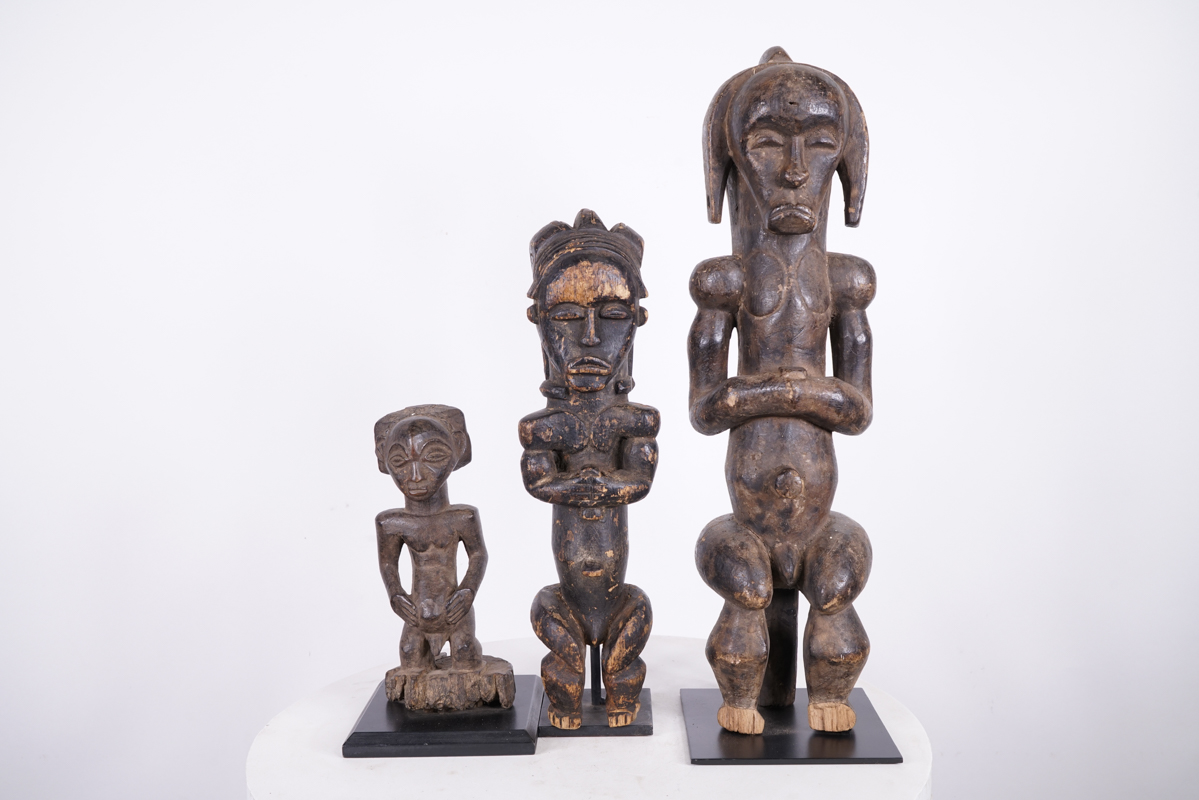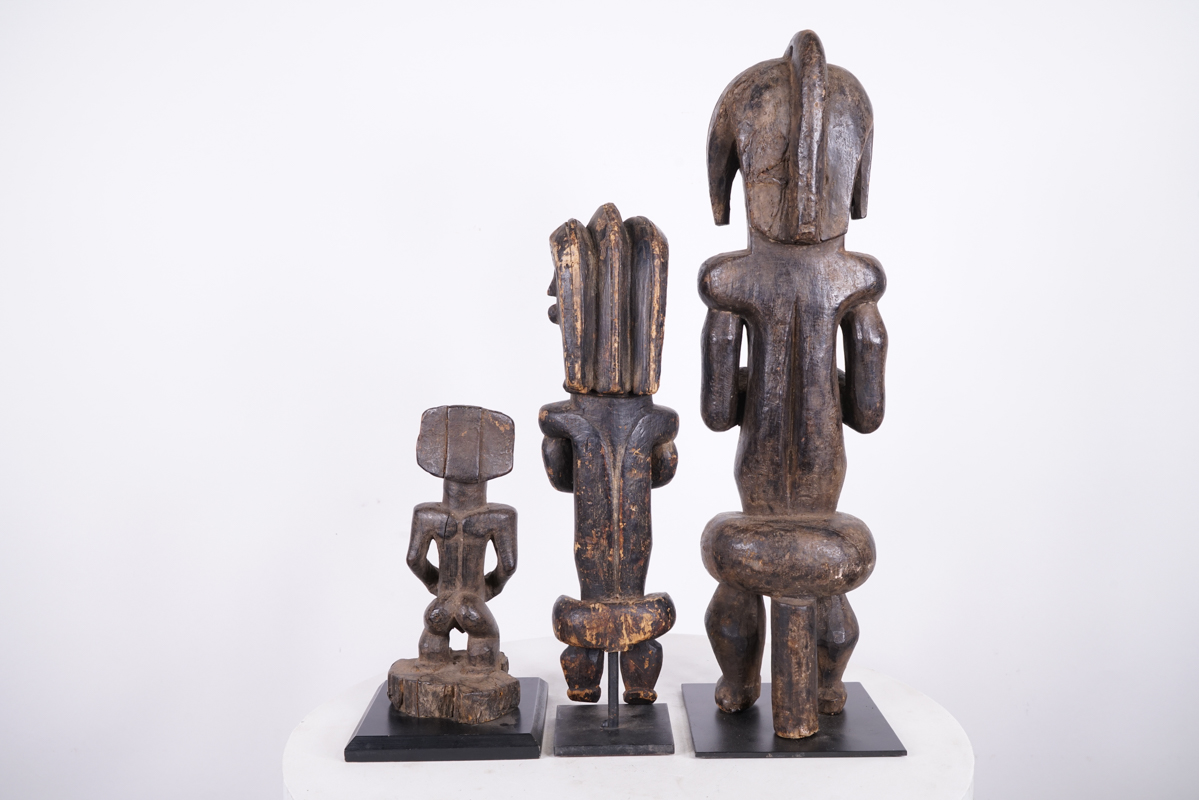These statues were carved in the style of Luba, Baule and Fang tribes of Sub-Saharan Africa. The statues feature three male figures attached to bases with their arms in front of their abdomens. The statues measure between 12-23.5 inches tall and weigh 2.5-6.5 pounds each. The pieces have cracking, some damage, scrapes and scuffs throughout – please inspect photos.
Luba, Baule & Fang Statue Lot 12″-23.5″- African Tribal Art
Original price was: $700.00.$175.00Current price is: $175.00.
Sold

| Type of Object | 3 statues |
|---|---|
| Ethnicity | Baule, Fang, Luba |
| Material | Wood, Pigment |
| Approximate Age | Unknown |
| Height (Inches) | 12"-23.5" |
| Weight (Pounds) | 2.5-6.5 lbs each |
Tribe Information
About the Baule People
The Baule are originally part of a breakaway group of the Akan people from Ghana. In the 17th century, Queen Abla Pokou led a group on an exodus away from the main Ashanti Confederacy after a war broke out due to disagreements among the factions. Pokou realized that she and her followers may be in harms way, so she took her people and headed westward. Legend says the group came upon the Comoé River, with its dangerous waters and needed a way to safely cross. With the enemy gaining on them, Queen Pokou asked a diviner for advice. The diviner, after much thought, told her the gods required a sacrifice. Everyone began throwing their most prized possessions into the river; gold, ivory, cattle, everything they owned, hoping to appease the gods. The diviner shook his head and said that our sons are our most prized possessions. Pokou, knowing that her duty as queen was more important than that of a mother, decided then to sacrifice her only son, throwing him into the water and calling out “Ba ouli”, translated to “the child is dead”, giving them the name Baule. After the sacrifice was made, hippopotamuses came up from the river and formed a bridge allowing the queen and her people to cross.
The Baule settled in what is now known as Côte d’Ivoire or Ivory Coast. They began defeating current inhabitants of the area and quickly became the middle man post for North and South trading routes. Towns and villages sprouted up with each being independent from one another, making their own decisions with the primacy of a council of elders. Smaller communities were usually governed by a village-chief whereas large villages were ruled by a king or queen. Considered an egalitarian society, everyone is equal and has a say in the overall agenda of the people, including slaves...
Read more about the Baule here.
About the Fang People
“Fang tribespeople migrated from the north-west during the 18th and 19th centuries and are today scattered across southern Cameroon, Equatorial Guinea and Gabon. They are principally hunters, but also farm. Fang social structure is based on the clan, a group of individuals with a common ancestor, and on the family. They also maintain tribal cohesion through the So and Gil societies. Each family possessed a Byeri, or reliquary box, in which the bones of famous ancestors were kept. The box was kept by the Esa, the eldest man in the family. “
Source:
Baquart, Jean-Baptiste. The Tribal Arts of Africa. New York: Thames and Hudson Inc. 1998. Print.
About the Luba People
“The Luba empire was founded in 1585 in the Upemba depression by King Kongolo. His nephew and successor, Kalala Ilunga, rapidly expanded the kingdom to encompass all the territories on the upper left bank of the Lualaba River. At its peak, about one million people, living in several tribes, were paying tribute to the Luba king. At the end of the 19th century, with the advance of the Ovimbudu people from Angola and the raids of the East African Muslim slavers, the empire weakened and, in fact, collapsed when Belgian colonials took control.
With the Assistance of a court of notables, called Bamfumus, the king, known as the Mulopwe, reigned over his subjects through clan kings called Balopwe/ These clan kings could symbolically become the Mulapwe’s son which created client states throughout the empire. A secret society, Bambudye, kept the memory of the Luba empire alive and permeated throughout Luba territory, bonding the diverse populations together. The Luba empire economy was complex – it was based on a tribute system and the redistribution of resources from agriculture, fishing, hunting and mining. The production of salt and iron was under the king’s control.”
Source:
Baquart, Jean-Baptiste. The Tribal Arts of Africa. New York: Thames and Hudson Inc. 1998. Print.
You must be logged in to post a review.



Reviews
There are no reviews yet.